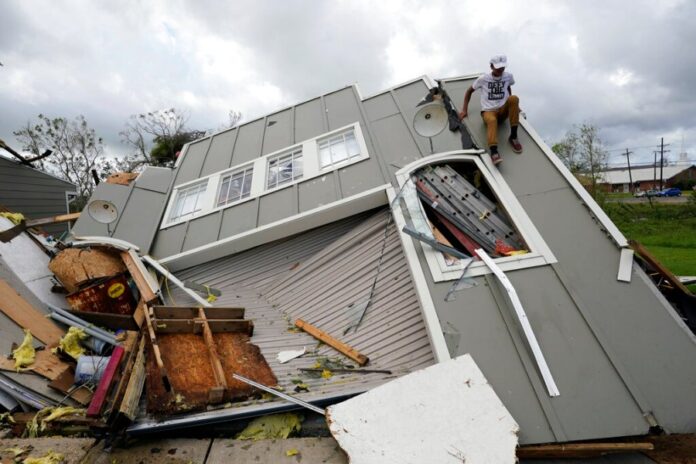
Hurricane which is a type of storm called tropical cyclone have been a usual feature in the United States of America (U.S.), but the frequency, intensity and the extent of damages left in their trail, keeps rising at alarming rates. The 2020 hurricane season broke records with 30 named storms, seven major hurricanes of Category 3 strength or higher and 10 storms that underwent rapid intensification.
Some of the most talked about hurricanes that have occurred in the U.S. several years back include but not limited to Hurricane Katrina, Hurricane Florence, Galveston Hurricane and Hurricane Sandy. However, on the 29 August 2021 which marks the 16th anniversary of Hurricane Katrina, a Category 4 hurricane named ‘Hurricane Ida’ lashed the region with winds of up to 150mph (240kph), heavy rain and several feet of storm. It proceeded to spin its way through Alabama and Tennessee toward the East Coast, where it is forecast to spread yet more severe weather in the form of rain and tornado-generating winds.
Ida’s Devastation
Hurricane Ida was the second-most damaging hurricane to strike the U.S. state of Louisiana on record, behind Hurricane Katrina. It is the deadliest hurricane the U.S. has seen in four years and the deadliest storm in the Northeast since 2012’s catastrophic Super storm Sandy, which killed more than 100 people.
It is also the joint-fifth strongest storm ever to make landfall on U.S. mainland. According to Entergy (an integrated energy company in the deep south of the United States of America), Louisiana’s power grid sustained more damage from Hurricane Ida than any other storm in state history.
According to reports, the storm caused damage to more than 30,000 utility poles, nearly 35,000 spans of wire and 5,600 transformers. It knocked out power to more than 900,000 households across southeast Louisiana. In addition, there were loss of lives with the nation reporting more than 60 people killed by the storm. Many of the victims drowned in cars or were swept away by flood waters.
Several deaths were also recorded because of carbon monoxide poisoning from backup generators running improperly. Just like any other hurricane, it caused half a million to remain without power as of Monday 30 August, according to PowerOutage.us. This resulted in Residents facing a concurrent heat advisory, especially dire as many lack the power to run air conditioning units. However, they were advised to seek out higher ground, stay vigilant after nightfall when flood dangers are harder to spot and to never walk or drive through floodwaters.
The occurrence of Hurricane Ida caused a temporary reversal of the course of the Mississippi River and shutting down nearly all of the natural gas and oil produced in the Gulf of Mexico (GoM). Ida’s 150 mile-per-hour (240 kph) winds also caused havoc on offshore oil production platforms and onshore oil and gas processing plants.
Early September 2021, about 88 percent of the region’s offshore oil production remained shut and more than 100 platforms were unoccupied after the storm made landfall. As of midday Monday 30 August 2021, 94 percent of the natural gas produced in the Gulf of Mexico (GoM), remained offline. Around 95 percent of the oil produced, also remained shut-in, as noted by the Bureau of Safety and Environmental Enforcement (BSEE).
It was reported that Hurricane Ida’s direct hit on the nation’s gasoil and gasoline industry has a tendency of increasing gas prices, which could worsen the plight of American consumers already having to deal with inflation. Expert predicted 10 cents increase per gallon in the Southeastern and Mid-Atlantic markets.
Apparently, how much prices will increase, and for how long, will depend on the extent of the damage. During Hurricane Katrina in 2005, the average price of a gallon of regular gas shot up 46 cents to US$3.07 a gallon, according to data from the Energy Information Administration (EIA). It took two months for gas prices to return to pre-Katrina levels after that storm.
Crude oil futures were higher in mid-morning trade in Asia on 30 August after Hurricane Ida forced the shutdown of more than 95 percent of the Gulf of Mexico’s oil production and the U.S. Dollar softened on latest indications from the U.S. Federal Reserve. Another concern is that major pipelines carrying gas, diesel and jet fuel from the Gulf Coast to other states were also shut as a precaution ahead of the storm. The shutdown of one of those, the Colonial Pipeline, after a computer hack earlier this year, caused price spikes and gasoline shortages along parts of the East Coast.
Climate Change Contribution
Climate change fingerprints was seen in hurricane Ida. Scientists say climate change is one reason the storm was so powerful. Experts say Hurricane Ida is an example of what storms could look like on a warming planet. It strikes the Gulf Coast on the heels of a major United Nation’s report finding strong evidence that climate change will make hurricanes rainier, slower, and more capable of explosive growth.
President Joe Biden when he visited Hurricane-damaged regions stated in his address ‘Things are changing so drastically in terms of the environment,’ linking the storm’s severity to climate change. Studies have shown that past storms like hurricanes Harvey in 2017 and Florence in 2018, two of the largest flooding events in U.S. history, “were astronomically unlikely” without climate change.
While scientists are uncertain whether climate change will increase the frequency of hurricanes, one thing is clear; Climate change is here, and it is making these storms stronger and more destructive. Until recently, it was common to think of climate change as a problem for future generations, saying people in the future will have to deal with it. Now it is quite clear that we are the people of the future.
The future has arrived, and we are having to deal with it now. Climate change is making disasters more destructive, more expensive and more impactful on humans. The latest report from the Intergovernmental Panel on Climate Change (IPCC), the world’s leading authority on climate science, found that storms with sustained higher wind speeds in the Category 3-5 range have likely increased in the past 40 years.
Several factors linked to the climate crisis including global sea-level rise and hotter ocean temperatures helped to fuel the storm. Hurricanes are being made more intense by the warming ocean, which studies have shown has absorbed roughly 90 percent of the planet’s excess heat trapped by human-produced greenhouse gas (GHG) emissions. Moreover, a recent study found that the planet is trapping roughly double the amount of heat than it did nearly 15 years ago.
A study published in 2019 in the journal “Nature Communication” found early evidence that climate change has likely made rapid intensification more common. In recent years, some of the most damaging hurricanes resulted from rapid intensification— Hurricane Laura in 2020, Hurricane Michael in 2018, and Hurricane Harvey in 2017, as noted by the report. While the ocean undergoes periods of natural warming that can supply hurricanes with more fuel.
Meanwhile, the study found an increase in rapid intensification surpassing those natural fluctuations. “Rapid intensification is a phenomenon that turns a storm from a predictable natural disaster, one that can be forecasted five to six days in advance, to an unpredictable one,” according to the lead author of the report, Kieran Bhatia.
For rapid intensification to occur, scientists notes that warm ocean water must extend well below the surface, going hundreds of feet deep, to provide enough engine for the hurricane to strengthen. This has led scientists to believe that storms are more likely to undergo rapid intensification because of warmer oceans.
Mitigating Measures
After establishing that climate change is a fingerprints seen in most hurricanes it is imperative to look out for mitigating measure to prevent it from getting worse. The most recently published IPCC report calls climate change “code red for humanity,” the boldest message in the report’s history, which was first, published in 1990. Since the publication of the first report, the world has witnessed a rapid rise in carbon emissions. In 2021, we are already at and surpassing 410 ppm, it notes.
There is therefore the need to go big on climate actions to cut or prevent the emission of greenhouse gases thereby limiting the magnitude of future warming. Mitigation may require greater climate change literacy campaign to be embarked on to mass educate and inform the public that some of these changes are irreversible and actions needs to be taken to have better outcomes in the future. Forest preservation, agriculture and reforestation is another great factor as researchers have known for decades that tree leaves absorb sunlight more than any other types of land covers such as fields or bare ground.
Other factors such as the use of new technologies, changing people’s behavior, or make older technology more energy efficient, would help mitigate the climate crisis. People may not only consider reducing climate change impact primarily by producing less waste, but also recycling more and treating waste in a way that is less harmful to the environment or even using it as a sustainable energy fuel source.
Another amazing option to help mitigate climate is to take-up renewable energy from sources that do not deplete over time. Figures from the United Nation (UN) show that though renewable energy raised its share of total energy generation last year from 7.8 percent to 8.5 percent, investment fell by 14 percent. The IPCC report published three months in advance of the upcoming UN Conference of Parties 26 (COP 26) galvanizes countries to further step up the commitments made in 2015 in Paris, through various forms of policy interventions, including clean energy.
Abisola works as Research and Policy Analyst at the IES. She holds a diploma in French language from Alliance français in Accra, a Bachelor’s of Science degree in Banking and finance (UPSA), and currently pursuing Masters of Business Administration in Accounting and finance (UPSA).









